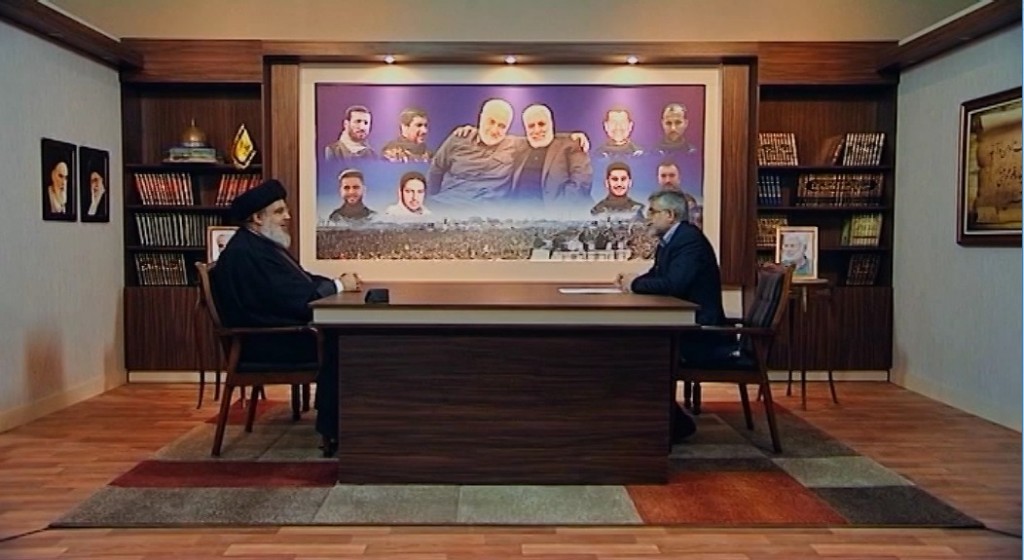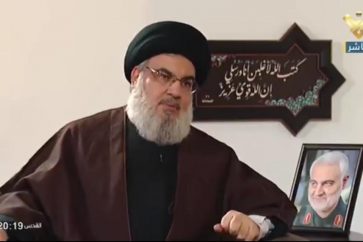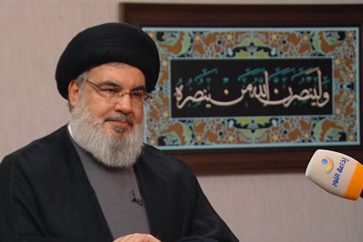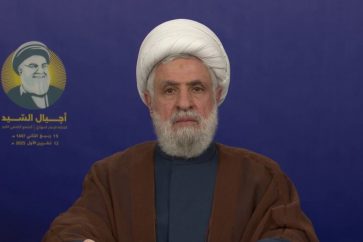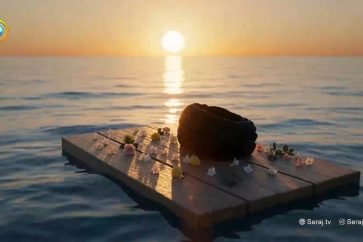Hezbollah Secretary General Sayyed Hasan Nasrallah spoke affectionately about Hajj Qassem Suleimani in an interview to an Iranian TV channel that was broadcast Thursday evening.
His eminence first spoke about the beginning of the relation with the Islamic Republic of Iran on the military level.
“It was in 1982 when the Israelis invaded Lebanon, occupying many areas and reaching Beirut. Imam Khomeini sent Iranian forces to Lebanon and their duty was to help the Lebanese establish a local resistance that could confront the Israeli occupation… This is how our ongoing relation with the Iranians emerged. Back then, Al-Quds brigade wasn’t established yet, but when the imposed war on Iran was over, Imam Khomeini ordered the formation of Al-Quds Force in the Revolutionary Guards Corps.
His eminence went back to the first days he met with leader of Al-Quds Brigade Hajj Qassem Suleimani. It was 22 years ago when he was appointed in this position.
“We had never met before that, even in our visits to Iran and our meetings with leaders there, Hajj Qassem was never present. He was either in the battlefields in Iran or fulfilling his duties in Karman, Sistan and Baluchestan.”
 “When he was appointed he came to Beirut and met with us, Hajj Imad and Hajj Mustapha Badreddine were among the attendees, and since the first moments we met, there was harmony and we felt that we knew each other since many years.”
“When he was appointed he came to Beirut and met with us, Hajj Imad and Hajj Mustapha Badreddine were among the attendees, and since the first moments we met, there was harmony and we felt that we knew each other since many years.”
His eminence considered that “Martyr Qassem Suleimani was a comprehensive figure, not just a military leader. We never felt that we are in front of a military specialist, instead he had wide knowledge on the political, economic, cultural, military, and security aspects… In addition to that, he built a strong relationship with Hajj Imad Mughnieh and other leaders in the resistance that was based on trust, love, friendship and loyalty. All this put us in front of a promising and powerful phase.
When asked about the background of the term “School of Qassem Suleimani or Office of Qassem Suleimani”, his eminence clarified that this is a reference to his unique approach in work that relies on constant visits and presence in the battlefields.
“It is true that he is the leader of Al-Quds Force but he barely stayed in Tehran. He personally joined the battlefields in Lebanon, Syria, Iraq, and other places and visited the groups he worked with, he didn’t wait for reports or for anyone to visit him in his office.”
“He had strong relations on different levels and this is the secret behind his success, his constant presence in the battlefield, building friendly and personal relations… his relation with Hajj Imad was the strongest, they were friends and more like family. His relation with Haj Imad was very similar to his relation to Martyr Ahmad Kazemi.”
““School or Office of Qassem Suleimani” is a reference to his path which requires observation. For instance, since we started working together we only visited Iran a couple of times, he was the one visiting us constantly, meeting with the leaders, joining the battlefields, expressing respect and showing high morals, listening to other points of view, listening to the sufferings and struggles in the battlefields… he never relied on reports, he joined the battlefields and witnessed everything himself. Despite all that, he never got tired, I have never met anyone who tolerated pain as much as Hajj Qassem did… He didn’t get bored or tired… He was consistent and perseverant… He was very humble despite his high position… This is something very rare and important.”
His eminence pointed out that Hajj Qassem was always on the front lines and under threat.
“He insisted on being with us in July war 2006. He arrived through Damascus and contacted us to send a car to pick him up. We told him it was impossible under this situation, he replied that he would come by himself if we didn’t send a car. When he came he stayed with us throughout all the war days… and if you listen to the resistance fighters in Iraq they would tell you that Hajj Qassem was always present in the most critical places in the battlefields there.”
“The School of Qassem Suleimani is taken from the school of Imam Khomeini, from the directions of leader Khamenei, and from the Iran war, which was a great experience on the intellectual, cultural, spiritual, and military levels. Hajj Qassem was the embodiment of this great experience…” Sayyed Nasrallah concluded this part saying.
Hezbollah SG referred to the great role of Hajj Qassem in supporting and developing the resistance capacities in Lebanon.
“He used to visit us every couple of weeks, not every couple of months. He used to visit the Southern Suburb mostly and he sometimes visited the South and met with the resistance fighters there.”
On another hand, Sayyed Nasrallah noted that “in the past we didn’t believe that the Israelis would pull out from the South under military pressure, because this would be a blunt and strategic defeat for them. When we met with Sayyed Ali Khamenei in the end of 1999 and revealed our doubts, his response to the political leaders was to keep it a supposition, but his response in front of the military leaders, was that you will witness liberation yourself.”
“… and there was the victory in 2000, and all those 50 leaders whom Sayyed Khamenei addressed that day witnessed the victory, no one got martyred before that day.”
In 2006, Sayyed Nasrallah said, “the Arab world, European countries, even Russia and China took a negative stance against us. Even internally, stances divided with and against the resistance. This put us under huge pressure, but the presence of Hajj Qassem among the fighters had a great influence on their morale… In July war, Hajj Qassem, Hajj Imad, and I where at the same place, but we worried that we would all be killed together, of course our worries were not out of fear from death but out of fear on our role and duties. So we separated, but Hajj Imad and Hajj Qassem stayed together all the time.”
“All 33 days, Hajj Qassem shared with us our happiness, sadness, affection… When the letter of the mujahedeen, then my response to them were recited on TV we were all crying out of affection. Hajj Qassem was with us.”
Hezbollah SG further referred to a letter he received from Sayyed Ali Khamenei through Hajj Qassem in which he expressed confidence that Hezbollah will triumph in the war and will become a regional power after that, at a time when everyone was wagering on our defeat.
“The letter revealed that the US and Israel were preparing for a surprise war on Lebanon in the end of summer 2006, but the captivity of those Israeli soldiers by Hezbollah removed the element of surprise and the resistance was prepared for any confrontation.”
As his eminence indicated that “Hajj Qassem Suleimani had a political and strategic mind, not just a military one. One of the ideas he introduced to Hezbollah was putting long term plans, he helped us put plans for years ahead,” asserting that “Hajj Qassem never focused on internal Lebanese details, all his concern was to preserve and strengthen the resistance.”
In response to a question about the day of Haj Imad Mughnieh’s martyrdom, Sayyed Nasrallah said that “Hajj Imad was with Hajj Qassem. They were together in a house in Damascus, then Hajj Imad took Hajj Qassem to the airport and on his way home he was assassinated. Haj Qassem instantly returned to the location, then he came and met me in Lebanon… it hurt him so much.”
Sayyed Nasrallah recalled the day of the formation of the Popular Mobilization Units in Iraq (Hashd Sha’abi).
“When ISIL emerged Hajj Qassem saw Iraq as his ultimate duty… On the day that Grand Ayatollah Sayyed Ali Sistani issued the fatwa calling for jihad against ISIL, Hajj Qassem came to me at 12 am and told me that by sunrise 120 military leaders must be available to travel with me to Iraq. He said he had no other choice in order to be able to defend the Iraqi people. By morning 60 leaders were ready and he did not leave before I assured him that the rest will follow him the next day.”
“He never asked for fighters. There are many fighters in Iraq, he only wanted leaders. I have said earlier that throughout 22 years this was the only request Hajj Qassem had asked from us.”
Sayyed Nasrallah and Martyr Abu Mahdi Al-Muhandis
“My first meeting with Hajj Abu Mahdi Al-Muhandes was in the early 90s in Iran. He was the leader of Badr Movement. He had a strong relation with Haj Imad and Haj Mustapha Badreddine, but the relation became stronger in the recent years due to regional developments and the war against ISIL,” Sayyed Nasrallah stated.
“In my last meeting with Hajj Abu Mahdi, we were discussing the Iraqi developments and analyzing military and security issues, then he told me that “the war with ISIL is almost over and I haven’t been martyred yet! Look at the white hair covering my head and beard… After all those years is it possible that I die in bed! He then asked me to pray for his martyrdom. Of course I haven’t prayed for a near martyrdom, but I prayed that when his life ends, it would be only through martyrdom.”
“Martyr Abu Mahdi was a faithful, devoted, religious, responsible person, and he had many common traits with Hajj Qassem, this is what build the significant relation between them.”
In conclusion, Sayyed Nasrallah referred to the last time he saw Hajj Qassem in.
“It was Wednesday and he was martyred early Friday. We sat for hours then prayed together… We did not have work to accomplish, he said he only wanted to see me… During his last visit he was very comfortable and relaxed, despite all the trouble around him. He even asked the photographers to take all those pictures for us. We don’t usually take this much pictures. I was worried about him.”
On the martyrdom, his eminence said: “The martyrdom of Hajj Qassem was historic. His funeral was unique in its size and level of affection! All the participants cried him as if they lost their dearest one. This level of affection only happens towards those who are very close to God.”
He reassured that “the US Administration had crossed the red-lines and people are now prepared for a confrontation with it. When a nation becomes aware of its real enemy it will fight it,” adding that “they wagered that Iran and the resistance axis will weaken after the assassination, but in contrast Iran showed great courage, and the axis of resistance advanced on several fields like Yemen and Iraq… I even received requests of individuals applying for self-sacrifice operations. The virtuous blood of Hajj Qassem and Hajj Abu Mahdi revived the spirit of revolution… their influence now is even stronger than before.”
“We are not worried; we are certain of our perseverance on this path. If we ever get tired or bored, the influence of Hajj Qassem and Hajj Abu Mahdi will urge us to continue even stronger.”
On the “Deal of the Century” his eminence stressed that “Hajj Qassem was a constant obstacle for the Americans, as he was present on various fields, so getting rid of him was important for the US to issue this deal.”
In a final word that he stated while trying to hold back his tears. Sayyed Nasrallah talked about a thought that came to him one day before the martyrdom of Hajj Qassem. It is that the angel of death gave him the privilege to choose between taking the soul of Qassem Suleimani or taking away his soul. His eminence asked him to leave Hajj Qassem and take his soul instead.
“I don’t say that just out of love and friendship, but also out of believe in the important role of Hajj Qassem in the Islamic Nation.”
Sayyed Nasrallah said “I thank Allah for knowing Hajj Qassem. I used to enjoy his company and trust him. I was always ready to sacrifice my life for his sake,” yet he reassured that “what happened was Hajj Qassem’s ultimate desire.”
Source: Al-Manar

